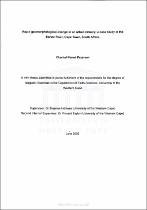| dc.contributor.advisor | Holness, Stephen | |
| dc.contributor.advisor | Taylor, Vincent | |
| dc.contributor.author | Petersen, Chantel Reneé | |
| dc.date.accessioned | 2023-05-15T09:38:51Z | |
| dc.date.available | 2023-05-15T09:38:51Z | |
| dc.date.issued | 2002 | |
| dc.identifier.uri | http://hdl.handle.net/11394/9958 | |
| dc.description | >Magister Scientiae - MSc | en_US |
| dc.description.abstract | The Eerste River estuary is one of eleven estuaries draining into False Bay. lt is an urban river system and has therefore been subjected to human interference, which has resulted in degradation. This study focuses on geomorphological change in the Eerste River estuary induced by urbanisation. Long-term spatial variability of the estuary and river environments was mapped using aerial photographs covering a period of 62 years (1938-2000). The earlier maps (1938-1977) showed the estuary to be seasonally closed to the sea by a wind and wave-built sandbar during summer. Both the Kuils and the Eerste Rivers were highly seasonal during this time and the estuary was only open to the sea during winter months. During the period 1988-2000 the estuary no longer closed but remained open throughout the year. This was due to the change in the hydrological characteristics of the rivers with increased river flows due to stormwater runoff and treated sewage outflow from several wastewater treatment plants. The increased flows also resulted in rapid westerly mouth migration, which caused extensive dune destruction. The morphology of the estuary changed from being a closed bar-built estuary to a permanently open bar-built estuary with no tidal influence. Short-term spatial variability in the geomorphology of the estuary was examined over a 12-month period. Nine cross-sections were used to determine the estuarine bathymetry and the sediment characteristics were determined along three. Significant floods occurred during the middle of the study period resulting in rapid geomorphological and spatial change. During the short-term study the estuary migrated back to an easterly position and due to a lower bed elevation pronounced tidal penetration occurred during spring high tides. The pre-flood survey showed little or no tidal fluctuation whereas the post-flood survey showed variations in water levels between low and high tides. Deposition occurred in all the cross-sections, which resulted in shallowing and narrowing of the main channel. A large amount of bed scour occurred, resulting in a lowering of the estuary bed, although it was not seen in all the cross-sections due to the continuing supply of sediment from upstream. Bank erosion was minimal where the vegetation aided in stabilisation, while significant undercutting occurred where no or sparse vegetation was found. Deposition was shown by the extensive sandbanks deposited after the flood and by a thin layer of fine sand which covered the vegetation on the right bank due to overbank flow. Sediment characteristics displayed by the estuary was of typical fluvial origin and marine sediment was found closer to the mouth. | en_US |
| dc.language.iso | en | en_US |
| dc.publisher | University of the Western Cape | en_US |
| dc.subject | Eerste River estuary | en_US |
| dc.subject | Geomorphology | en_US |
| dc.subject | Temporal changes | en_US |
| dc.subject | Mouth migration | en_US |
| dc.subject | Flood effects | en_US |
| dc.title | Rapid geomorphological change in an urban estuary: a case study of the Eerste River, Cape Town, South Africa. | en_US |
| dc.type | Thesis | en_US |
| dc.rights.holder | University of the Western Cape | en_US |

